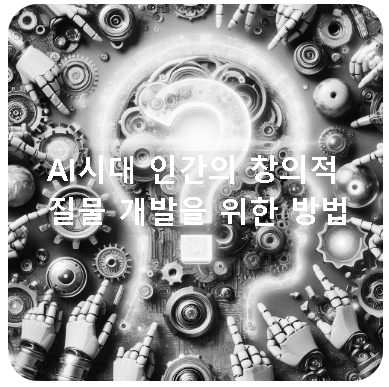The Importance of Human Creativity and Education in the Age of AI
The Importance of Human Creativity and Education in the Age of AI
In today’s rapidly evolving world of artificial intelligence (AI), it has become nearly impossible for humans to match the speed and computational power of machines. AI excels at tasks such as data analysis, translation, and communication—breaking through human limitations and interconnecting the global community like never before. In this context, the ability to leverage AI effectively has emerged as a key determinant of both individual and societal competitiveness.
Contrary to fears that AI will make human roles obsolete, this new era underscores the value of uniquely human traits—especially creativity, critical thinking, and the ability to ask meaningful questions. To use AI as a true partner, we must cultivate the human capacity to define problems, set directions, and generate solutions rooted in creative thought.
1. Human-AI Coexistence: Complement, Not Competition
While AI can process vast datasets and generate highly accurate outputs at lightning speed, it cannot replicate human imagination, emotional insight, or complex moral reasoning. For example, AI can suggest new ideas based on learned patterns—but reframing problems or thinking outside established paradigms remains a distinctly human strength.
Therefore, humans and AI should not be seen as rivals, but as complementary collaborators. Creating environments where AI enhances human creativity—not replaces it—is essential to unlocking future innovation.
2. The Power of the Right Questions
In the age of AI, asking the right questions has become more important than simply finding answers. Questions are not merely requests for information—they serve as the foundation for understanding problems, shaping solutions, and sparking discovery.
High-quality questions share three key characteristics:
-
Clarity – A well-formed question clearly defines its purpose and context.
-
Depth – It provokes thoughtful insight and critical examination.
-
Openness – It invites exploration of diverse possibilities and perspectives.
For instance, the broad question “How can AI help solve climate change?” opens a valuable discussion. But a more targeted inquiry like “How can AI be used to predict regional climate impacts and support local adaptation strategies?” leads to more practical, actionable insights.
 |
| The era has reached a point where we cannot turn our backs on artificial intelligence. Just like how we feel uneasy when we lose our smartphones. |
3. Reading: A Gateway to Creative Questioning
Creative questioning doesn't arise in a vacuum—it requires a foundation of broad knowledge and diverse viewpoints, which are best cultivated through sustained reading. Reading enhances our capacity to think creatively in several important ways:
-
Expanding Intellectual Horizons – Engaging with different subjects, cultures, and viewpoints nurtures curiosity and original thinking.
-
Strengthening Critical Thinking – Analyzing and interpreting complex texts fosters independent reasoning and sound judgment.
-
Inspiring New Ideas – Literature, history, and philosophy provide rich sources of insight into human nature, societal challenges, and alternative ways of thinking.
In particular, literature sharpens our understanding of emotion and human experience, while history and philosophy develop the long-term thinking and ethical reflection needed to ask deeper, more meaningful questions.
4. Rethinking Education for the Creative Age
To nurture individuals who can thrive in the AI era, education must evolve beyond rote memorization and test-based evaluation. We need transformative approaches that prioritize creativity and real-world problem-solving. Effective educational strategies include:
-
Problem-Based Learning – Rather than teaching students to memorize solutions, encourage them to define problems and explore solutions through inquiry and experimentation.
-
Interdisciplinary Education – Connecting different fields—such as science, art, technology, and humanities—helps learners develop broader, integrative perspectives.
-
Experiential Learning Through Case Studies – Education should be grounded in practical challenges and project-based work that mirrors real-world complexity.
These approaches empower students not only to use AI tools effectively, but also to direct them toward meaningful purposes.
 |
| The utilization of artificial intelligence must be guided by uniquely human philosophy and values, to ensure the coexistence of nature and technology. |
5. The Future Is Human-AI Collaboration
To build a better future, we must go beyond using AI as a mere tool. Instead, we must embrace it as a creative partner capable of amplifying what humans do best—dream, question, feel, and innovate. Achieving this vision requires a balanced integration of technological fluency with irreplaceable human abilities like empathy, ethical judgment, and creative thinking.
Our educational systems must reflect this priority by cultivating a new generation equipped not just with digital skills, but with the wisdom and imagination to lead in an AI-augmented world.
Conclusion
Rather than racing to keep up with technology, we should focus on enhancing the human qualities that AI cannot replicate. Creative thinking, thoughtful questioning, and emotional intelligence are not just valuable—they are essential in guiding AI toward outcomes that truly serve humanity.
By fostering these uniquely human strengths, we can move beyond fear and embrace a future where humans and AI work side by side to solve complex problems and build a more just, innovative, and compassionate world.
by pre2w
Here are some interesting articles you might enjoy
Human Brain vs Thousands of Computers – Was It Ever a Fair Fight?




Comments
Post a Comment